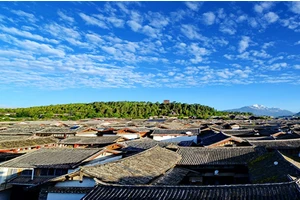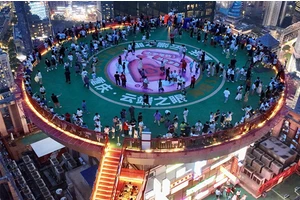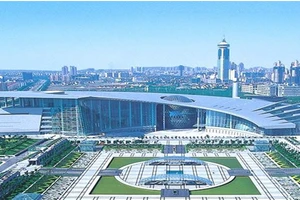Nanjing Liancheng tourism
1. Nanjing Sun Yat-sen Mausoleum Tourism Route
It depends on your specific itinerary. Sun Yat-sen Mausoleum has a wide range, among which Sun Yat-sen Mausoleum is free. This 40-minute tour is enough. The main thing is to walk up the long stairs and pay a visit to Dr. Sun Yat-sen, but to include other paid scenic spots and famous scenic spots, two hours is very tense.
For example, Linggu Temple, Linggu Temple, Guling Pagoda and places where rice is worth playing will take at least one and a half hours or even longer; Ming tomb, where Zhu Yuanzhang's mausoleum and Meihua Mountain are located, will take at least 2 hours.
植物园2小时左右也可以玩,不然赢了不值得买这些票。
音乐台、夏紫湖、水榭不推荐。它it’在这里消磨时间,你可以消磨一下午。所以2个小时很有压力~除此之外,玩的时候还有很多不确定的因素,比如交通,走路速度等等。所以只建议主要玩中山陵,然后走一走藏经阁和林荫大道。其他景点只能下次时间充裕的时候去玩了。希望回答对你有帮助。玩得开心!
2.南京中山陵风景区攻略
乘坐9路公交车直达中山陵(dondon’不要坐地铁,它太贵了。s很长的一段路),然后在中山陵景区乘坐公交线路,在十三陵下车,最后从十三陵乘坐20路公交车到索道。一般人从盘山路走上去到天文台(30分钟左右),或者坐索道。
3.南京旅游景点中山陵
南京中山陵门票80元,明陵门票70元
1.身高1.3米以下儿童免费;
2.南京60岁以上老人凭老年证免费;
3.残疾人凭残疾证免费;
4.退休干部凭退休证免费。
中山陵门票包括:艾博牌坊、陵门、碑亭、中山陵、面食小王子亭、杨志亭、小井顶、行健亭、光华亭、孙中山纪念馆:藏经楼、中山书院、灵谷寺:洪山门、灵谷寺、古灵塔、无量堂、民国革命阵亡将士纪念广场、万公池、灵香亭、嵩松。
Nanjing Sun Yat-sen Mausoleum is open from 06: 30 to 18: 30.
Sun Yat-sen Mausoleum will be opened free of charge on the important anniversary of Sun Yat-sen (August 26th, 2009).
4. Nanjing Sun Yat-sen Mausoleum tourist route map
The best tour route: Avenue-Xingjian Pavilion-Paifang-Lingmen-Beiting-Memorial Hall-Yongmu Road-City Hall-Sun Yat-sen Memorial Hall-Yangzhiguan-Liuhuixie-Music Station.
Sun Yat-sen Mausoleum is located in Zhongshan Scenic Area at the southern foot of Zijinshan Mountain in Xuanwu District, Nanjing. It faces Pingchuan, with green barriers on its back, Linggu Temple in the east and Ming Tombs in the west. The whole building complex is built according to the mountain trend and gradually rises from south to north along the central axis. The main buildings are Boai Square, Tomb Road, Mausoleum Gate, Stone Steps, Monument Pavilion, Memorial Hall and Tomb, which are arranged on a central axis, reflecting the style of traditional architecture in China. It combines the essence of ancient China and western architecture, solemn, simple and unique.
Sun Yat-sen Mausoleum is the mausoleum of Sun Yat-sen, the forerunner of the great revolution. The coffin was placed here on June 1, 1929. The main buildings of Sun Yat-sen's Mausoleum are arranged on a central axis, which embodies the traditional architectural style of China. The cemetery faces south, presenting an alarm bell. The memorial hall is a palace-like building with three arches, and the lintel is engraved with nationality, civil rights and people's livelihood. There is a marble statue of Dr. Sun Yat-sen in the hall, and the full text of the teacher is engraved with the outline of the founding of the People's Republic of China in S calligraphy on the wall. The Sun Yat-sen Mausoleum gradually rises from south to north along the central axis, followed by the square, the stone square, the tomb road, the mausoleum gate, the tablet pavilion, the memorial hall and the tomb.
Welcome to Sun Yat-sen's coffin. A road named Zhongshan Road was built from Xiaguan Wharf in Nanjing to Sun Yat-sen Mausoleum (now Zhongshan North Road, Zhongshan Road and Zhongshan East Road in Nanjing). All the places where the coffin passes are in honor of Zhongshan and Yixian. (Zhongshan pier of Zhongshan Bridge)
5. Nanjing Sun Yat-sen Mausoleum Tourism Route Map
Sun Yat-sen Mausoleum is located in Xuanwu District, Nanjing. The specific location is No.7, Shi Xiang Road, Xuanwu District. Sun Yat-sen Mausoleum is located at the southern foot of Kitten in the eastern suburb of Nanjing, adjacent to Ming Mausoleum in the west and Linggu Temple in the east. Built on the mountain, it gradually rises from south to north along the central axis. The whole building complex rises layer by layer according to the mountain, and the momentum is magnificent.
Sun Yat-sen Mausoleum in Nanjing, facing south, covers an area of more than 80,000 square meters. The memorial hall is a palace-like building with three arches. The main buildings of Sun Yat-sen Mausoleum include memorial archway, tomb entrance, tablet pavilion, memorial hall and tomb room. Looking down from the top, Sun Yat-sen Mausoleum looks like a liberty bell lying flat on a green carpet. The architectural style of Sun Yat-sen Mausoleum is a combination of Chinese and Western. Sun Yat-sen Mausoleum is magnificent, connecting all archways, mausoleum gates, tablet pavilions, memorial halls, tombs and Tian Tong steps into a whole, which is majestic.
6. Nanjing tourist attractions must go to Sun Yat-sen Mausoleum.
1. Sun Yat-sen Mausoleum Scenic Area
Highlight: Sun Yat-sen Mausoleum is the democratic revolution of Sun Yat-sen's mausoleum, which is known as the father of the Republic of China and the forerunner of China.
2. Nanjing Zhongshan Scenic Area
Highlight: Known as the first mountain of humanities in Chinatown, it is divided into three scenic spots, and the Sun Yat-sen Mausoleum and the Ming Mausoleum are the must-see places.
3. Meiling Palace
Highlight: Song Meiling's former residence is well preserved.
4. Meihua Mountain
Highlight: One of the famous plum viewing resorts in China. Sun Quan, Emperor Wu of the Three Kingdoms and Lady Bu were buried here, which is the earliest mausoleum of the Six Dynasties in Nanjing.
5. Music station
Highlight: Sun Yat-sen Mausoleum, one of the scenic spots, has distinctive architecture.
6. Shi Xiang Road
7. Nanjing Zhongshan Botanical Garden
Highlight: The first national botanical garden in China is one of the four major botanical gardens in China.
8. Ming Tombs Museum
9. Liuhui Pavilion
Highlight: The environment is pleasant, which is very suitable for families of all ages.
10. Meihuagu Park
7. Nanjing Sun Yat-sen Mausoleum Scenic Area Travel Guide
Bus route: d2 subway s8 subway line 3 subway line 2 sightseeing bus line 1, with a total length of about 34.8 kilometers.
1. Walk about 250 meters from Dachang to Xinhua Road Far East Road Station.
2. Take bus d2 and arrive at Nanjing University of Information Science & Technology Station after five stops (or take bus 642 or bus y25 at night).
3. Walk about 270 meters to the Information Engineering University Station.
4. Take the subway line s8, pass 2 stops and arrive at Taifeng Road Station.
5. Walk about 210 meters and transfer to Metro Line 3.
6. Take Metro Line 3, pass 10 stops and arrive at Daxing Palace Station.
7. Walk about 220 meters and transfer to Metro Line 2.
8. Take Metro Line 2, pass three stops and arrive at Alfalfa Park Station.
9. Walk about 500 meters to Alfalfa Garden (subway station) station.
10. Take sightseeing bus line 1, pass 4 stops and arrive at Sun Yat-sen Mausoleum South Station.
11. Walk about 150 meters to Sun Yat-sen Mausoleum Scenic Area.
8. How to take the tourist route of Nanjing Sun Yat-sen Mausoleum?
The best tour route: Avenue-Xingjian Pavilion-Paifang-Lingmen-Beiting-Memorial Hall-Yongmu Road-City Hall-Sun Yat-sen Memorial Hall-Yangzhiguan-Liuhuixie-Music Station.
Sun Yat-sen Mausoleum is located in Zhongshan Scenic Area at the southern foot of Zijinshan Mountain in Xuanwu District, Nanjing. It faces Pingchuan, with a green ridge on its back, Linggu Temple in the east and Ming Tombs in the west. The whole building complex is built according to the mountain trend and gradually rises from south to north along the central axis. The main buildings are Boai Square, Tomb Road, Mausoleum Gate, Stone Steps, Monument Pavilion, Memorial Hall and Tomb, which are arranged on a central axis, reflecting the style of traditional architecture in China. It combines the essence of ancient China and western architecture, solemn, simple and unique.
Sun Yat-sen Mausoleum is the mausoleum of Sun Yat-sen, the forerunner of the great revolution. The coffin was placed here on June 1, 1929. The main buildings of Sun Yat-sen's Mausoleum are arranged on a central axis, which embodies the traditional architectural style of China. The cemetery faces south, presenting an alarm bell. The memorial hall is a palace-like building with three arches, and the lintel is engraved with nationality, civil rights and people's livelihood. There is a marble statue of the doctor here.
The hanging button equivalent to the whole clock, located in the south of Mausoleum Square, was completed in the autumn of 1933. It was donated by Sun Yat-sen University and Dai's classmates. There is a hexagonal bronze medal in the tripod, engraved with the words of filial mother, which says that wisdom, kindness and courage are cast on the tripod surface.
Aibo building
There is a tall granite arch at the entrance of the mausoleum, on which there are two golden characters of fraternity written by Dr. Sun Yat-sen. Behind the Stone Square is a pyramid-shaped mound 375 meters long and 40 meters wide.
Lingmen
The entrance of the tomb is in front of the entrance of the tomb, with blue glazed tiles on the top. On the forehead of the gate is Sun Yat-sen's handwriting. The world is public. The use of blue glazed tiles has certain implications. Blue symbolizes heaven, and blue glazed tiles symbolize the world.
There is a stone tablet hidden in the pavilion.
The pavilion is approximately square, 12 meters wide and 17 meters high. A 9-meter-high stone tablet is engraved with Tan (the other three are Yu Youren, Hu and Wu Zhihui), then Chairman of the National Government, Executive Dean and one of the four calligraphers of the Kuomintang. In this book, China Kuomintang buried Prime Minister Sun Yat-sen on June 1st, 18th (Sun Yat-sen resigned as interim president because Yuan Shikai promised to recommend Yuan as his generation, and Yuan Shikai became the first president of the Republic of China and was buried in the name of Kuomintang Prime Minister). Elegant writing.
The stone steps
From the archway to the memorial hall, there are 392 stone steps and 8 platforms with a drop of 73 meters. The 32 stone steps symbolize that the population of the Republic of China at that time was 392 million. The steps are made of Suzhou granite. The highest platform has two China watches, behind which is a memorial hall.
Sacrificial hall
The memorial hall is the main building of Sun Yat-sen Mausoleum, located at the highest peak of the mountain, which combines Chinese and western architectural styles. It is 28.7 meters high, 30 meters long and 24.7 meters wide. The three arches in the south of the memorial hall are carved with red and copper double doors, and the foreheads of the gates are engraved with: democracy, civil rights and people's livelihood. There is an inscription by Sun Yat-sen on the door.
In the center of the hall, a 4.6-meter-high statue of Sun Yat-sen is dedicated. It was carved with Italian white marble by the world-famous sculptor Paul Landovsky in Paris, France, with six reliefs on the base, which was a revolutionary activity of Sun Yat-sen.
The marble on the east and west walls of the hall is engraved with Sun Yat-sen's posthumous calligraphy "Outline of the Founding of the People's Republic of China". There are two tombs at the back of the hall. The two front doors are made of copper and the doorframes are made of black marble. With Sun Yat-sen's banner calligraphy, Qi Hao is forever. The double doors are made of single copper, and the stone carving Sun Yat-sen's tomb is carved on the doors. It is a circular tomb with a diameter of 18 meters and a height of 11 meters. There is a long pyramid-shaped mound in the center of its tomb. In front of the tomb, there is a white marble statue of Sun Yat-sen with Sun Yat-sen's body buried under the water. The tomb is 5 meters deep and sealed with reinforced concrete.
There are relief revolutionary deeds reflecting Sun Yat-sen around the hall. On the marble of the east-west retaining wall of the hall, Sun Yat-sen's legacy "Outline of the Founding of the National Government" and Hu et al.' s handwriting "Outline of the Founding of the People's Republic of China" are engraved, and the dome is painted with a huge Kuomintang party emblem. There are two tombs at the back of the hall. The two front doors are made of copper and the doorframes are made of black marble. With Sun Yat-sen's banner calligraphy, Qi Hao is forever. The double doors are made of single copper, and the stone carving Sun Yat-sen's tomb is carved on the doors.
Coffin room
It is a circular tomb with a diameter of 18 meters and a height of 11 meters. The tomb is 165 meters above sea level, 700 meters from the starting plane, with a drop of 73 meters. The top of the Kuomintang party emblem is inlaid with colorful mosaics, and the ground is covered with white marble. It is a long central tomb with a white marble statue of Sun Yat-sen, which was carved by Czech sculptor Gao Qi according to the remains. Sun Yat-sen's body is buried below. An American-made copper coffin was used to bury it. The tomb is 4m in diameter and 5m in depth, and is sealed with reinforced concrete.
In Sun Yat-sen's mausoleum, there are some important figures of modern democratic revolution, such as Sun Yat-sen's close comrades-in-arms and Kuomintang politicians. In 1928, the national government decided to rebuild the cemetery of fallen soldiers of the National Revolutionary Army at the site of Linggu Temple on the east side of Sun Yat-sen Mausoleum, adding memorial archways, memorial halls and memorial towers. The names and ranks of soldiers killed in the Northern Expedition and the Anti-Japanese War are engraved in the memorial hall reconstructed from the Wuliangtang of Linggu Temple. It is estimated that there were 10 monuments engraved with more than 33,000 names. At the northern foot of Zhongshan, there is also a solemn air martyr cemetery, and the tombstone is engraved with the names of 3,306 martyrs from China, the United States, the Soviet Union and other countries who died in the war against Japan.
Some suggestions for everyone:
Sun Yat-sen Mausoleum, closed on Monday. Visitors should not visit Sun Yat-sen Mausoleum on Monday, or you will come for nothing.
2) Sun Yat-sen Mausoleum does not need tickets, but there are tickets at Ming Mausoleum, Linggu Temple and Sun Yat-sen Mausoleum Music Station near Sun Yat-sen Mausoleum. I suggest you buy a joint ticket at a reasonable price. Sun Yat-sen Mausoleum is only a part of Zhongshan Scenic Area, which is very big and famous. It's also worth visiting.
3) Transportation: Take Nanjing Metro to Metro Line 2, and exit at Sun Yat-sen Mausoleum. There is a battery car in Sun Yat-sen Mausoleum Scenic Area, 10 yuan/person. Of course, you can walk, but it's a little far.
Mausoleum buildings are symmetrically arranged on the gentle slope at the southern foot of Zhongmao Mountain according to the north-south axis. Looking down from the air, Sun Yat-sen Mausoleum looks like a recumbent liberty bell, which means Mu Duo warns the world. The tripod in the lower well is the spire of the bell, the half-moon square is the arc of the bell, and the top of the tomb is like a circular pendulum hammer. It means to arouse the people to build the Republic of China.
The stone archway and the long pyramid-shaped mound at the south entrance are like a rope hanging under a clock. The pyramid-shaped mound faces south and is built on the mountain, and gradually rises from south to north along the central axis. There are squares, stone squares, tombs, tombs, pavilions, stone steps, large platforms, memorial halls, tombs and other buildings on the central axis. Together with the surrounding walls, they form the main body of the clock. The highest memorial hall is the core building of the mausoleum, 700 meters away from the archway plane and 73 meters vertically. The tomb behind the memorial hall is the bell button of the big clock.
There is a tall granite arch at the entrance of the mausoleum, on which there are two golden characters of fraternity written by Dr. Sun Yat-sen. From the archway to the memorial hall, there are 392 stone steps, representing 392 million compatriots in China at that time; Eight platforms symbolize the three-person American principle and the five-power constitution. The steps are made of Suzhou granite.
The whole mausoleum is made of blue glazed tiles and granite, which is solemn and solemn. Blue symbolizes the blue sky and also conforms to the color of the national flag of the Republic of China: the sky is red. The blue sky symbolizes the aboveboard, lofty and great personality and ambition of the Chinese nation. The blue glazed tile symbolizes that the world is public and shows Sun Yat-sen's broad mind for the country and the people.
If you sign up for a tour, you don't have a separate trip to Nanjing. They are all trips to nine cities in East China, probably a little over 2,000.
If you go by yourself, it depends on how you get there. If you go by train, the events are quite long. You have to leave around 20 o'clock in Jinzhou at the earliest and arrive at 9 o'clock the next day. The soft berth is 488.5, the hard berth is 310.5 and the hard seat is 180.5.
To travel by high-speed train, you need to take G398 Jinzhou South at 9:56, arrive at Beijing South at 13:21, take G139 in Beijing South at 13:40, arrive at Nanjing South at 18:22, or take G3 at 14: 00 and arrive at Nanjing South at 17:41. Basically, you will arrive at Beijing South at 13:21, and the high-speed train to Nanjing South will arrive on the same day.
From Jinzhou South to Beijing South G398, Business Block 721.5, First Class Block 363, Second Class Block 231.
Beijing South to Nanjing South High-speed Railway, business seat 1403.5, first-class seat 748.5, second-class seat 443.5.
If you fly, there is no direct flight to Jinzhou. You need to go to Shenyang or Beijing directly, or you can take the daily flight from Jinzhou Bay Airport to Shanghai and then transfer, or you can transfer to Hangzhou.
You can buy Jinzhou Bay-Shanghai Pudong-Nanjing Lukou connection, which costs more than 1300-1600 yuan. In short, you need to stay at Pudong Airport for nearly 10 hours, and you can get to Nanjing at almost zero in the evening. It is not recommended.
If you want to fly from Shenyang, take the Huyue Taoxian Airport shuttle bus from Jinzhou, and the cost seems to be 76. This bus is a normal Huyue bus from Jinzhou, and there will be 7 business buses to pick you up and take you to the airport after leaving the expressway in Shenyang. This line runs four times a day, leaving Jinzhou at 6:00, 7:00, 10:30 and 13:40 in the morning. It takes more than three hours to arrive at Taoxian Airport, and there is no traffic jam for three hours and 15 minutes. The traffic jam may be delayed a little, and then you can take the flight from Taoxian Airport to Nanjing, which can cost anything. In short, the earlier you book, the cheaper it will be, and it will cost about 7,000 yuan in the last month or two.
Prev: Sixi travel
Next: Guilin tourism economy






